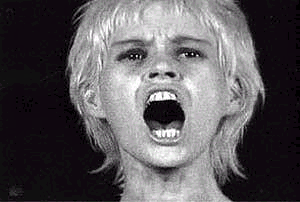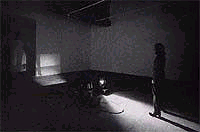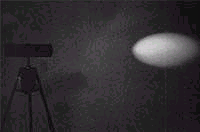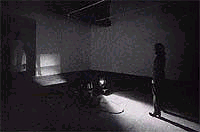|
Gary Hill: The Performative Image
|
|
| Are artists just philosophic crash-test dummies for the poetics
of life? In his video installation titled "Wall Piece", Gary Hill throws
himself at a wall every time he utters a word. "Wall Piece" consists of
300 or more words and leaps against the wall. A strobe light flashes with
each futile leap making it more difficult to watch. Four other video installations,
equally demanding, are on exhibition at the Watari-um Gallery of Contemporary
Art. Gary Hill's installations exist in the cracks somewhere between performance,
video and poetry. They are dramatic explorations into aspects of language,
image and memory. |
|
| On leaving the elevator on the first floor you enter a dark gallery
space. In the darkness you are just able to make out a tripod with some
sort of lens and light on it. The light's moving and you stand letting your
eyes adjust to the darkness. Slowly the light revolves and you are now caught
in the spotlight. Stunned like an deer on a country road, you stand blinded
and confused as the light grinds past you. On wandering in to take a closer
look, you witness the spotlight reaching the far wall. An image begins to
focus --- the sound of waves are heard just as the image of the sea becomes
clear. As if seen through a ship's porthole, the ocean is momentarily visible
until the light rotates out of focus again --- and the "Searchlight" continues.
|
|
| In the same room as "Searchlight," and almost overpowering it,
is "Remembering Paralinguay." In this video projection a woman walks towards
you gradually getting larger and clearer. She utters noises that are incomprehensible
--- not speaking, not singing --- but almost musical. With great passion
she continues but you can only stand there, moved by her emotion, but confused
by her incomprehensible utterances. |
|
| Video art exists somewhere between the reflective stillness of
paintings in art galleries, the technical wizardry of movies and the immediacy
of television. Gary Hill uses video technology to scrutinize life through
staged performance. His installations help us to study more intently the
scenario he presents on screen. An example of this is "Crossbow" which consists
of three LCD screens mounted on a wall in a triangular array. The videos
which play on the screens were shot with three different cameras --- one
attached to each arm and one on his back. |
|
| We are shown a three-way vision of Hill writing in a scrap book.
The camera behind him shows the back of Hill's head and neck allowing the
viewer to look over his shoulder. While the camera on each arm views the
other hand at work. The words he writes conjure up concepts of left and
right. We watch his hands handling the pen and pages trying to arrange the
words logically. We witness the left side brain controlling the right side
writing, each side recording. Hill enjoys word play. The title of the work
"Paralinguay" is an anagram of Gary (Hill) and Paulina (Wallenberg-Olsen),
the performer in the video. |
|
| Another work titled "Rorrim room Mirror" uses the mirror reflection
of the letters. In this installation, a video camera and projector record
and project a room, mirroring its own image back on itself --- technologies
looking and showing, canceling themselves null and void. Hill's art is a
workshop of ideas --- experiments in the poetry of recorded image. "Am I
simply tapping myself on the shoulder?" he inquires in the video as he jumps
up against the wall. "What's the point?" he asks, questioning our lives.
|
|
|
The Watari-um Museum of Contemporary Art
3-7-6 Jingumae Shibuya-ku Tel. 03.3402.3001 (Ginza line
to Gaienmae)
Open 11:00 - 19:00 (until 21:00 Wednesdays) Closed Mondays
through January 14, 2001 Fee ¥1000, Students ¥800
|
BACK
|



